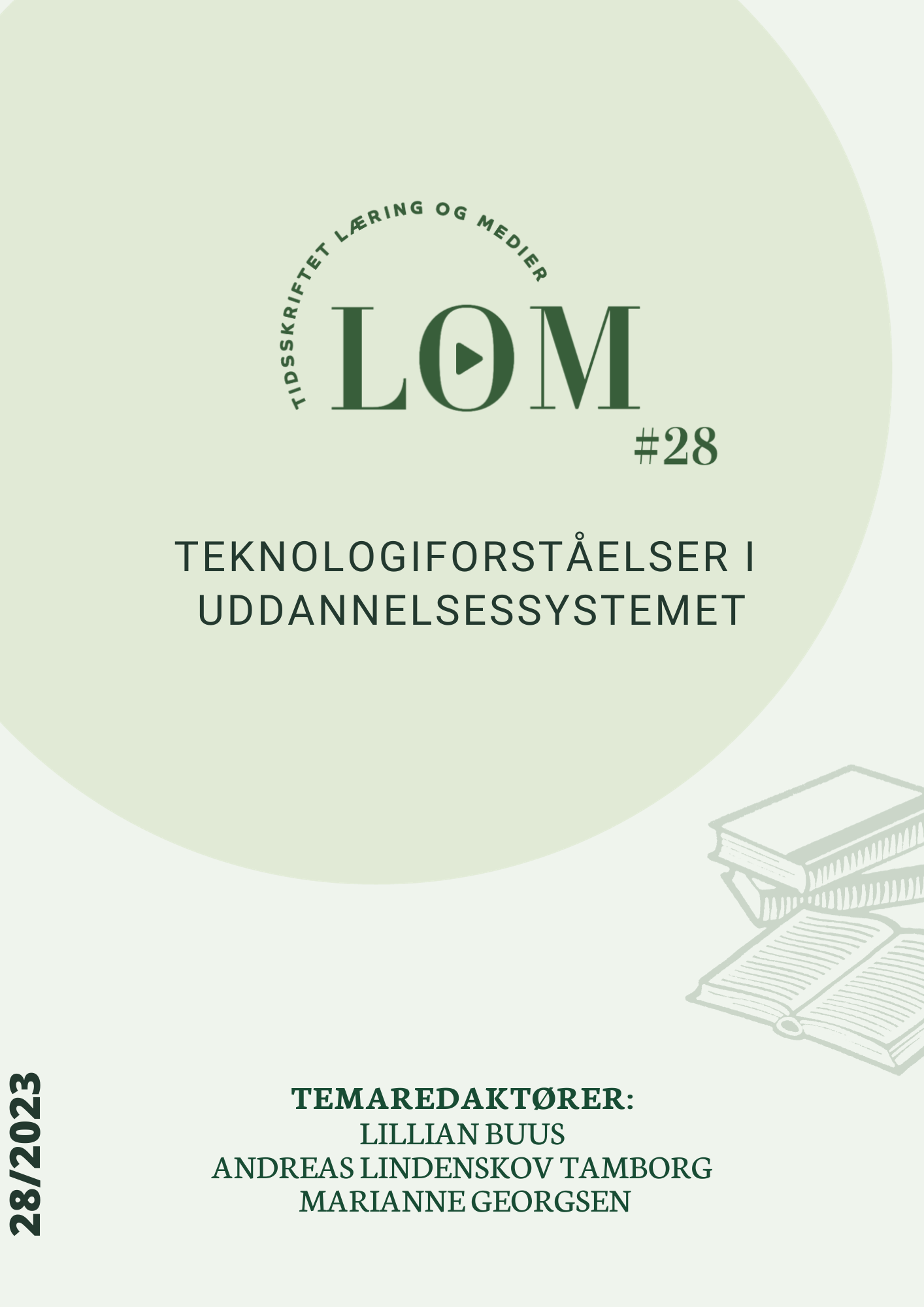Teknologiforståelse som undervisningsfag på læreruddannelsen
Studerendes værdisætning af programmering som et badge of membership
DOI:
https://doi.org/10.7146/lom.v16i28.136116Keywords:
Materialitet, computationel tankegang, Læreruddannelse, Lærerstuderende, LæreprocesserAbstract
This article contributes with new knowledge about student teachers' technology-related learning processes in the subject technology comprehension in teacher training. Through special attention to materialities, computational thinking and technological ability and skills, three cases from the first semester of teaching are examined. Case 1 illustrates a group of students with a great commitment to a design process with many materialities, where computational technologies lie outside their project. Case 2 demonstrates how different materialities help shape the students' learning process, just as some technologies and skills achieves a special status. Case 3 shows how a group of students work both with and against digital technologies in a complicated exploration of material forms of expression and participation. Overall, the article provides new knowledge about an emerging academic culture characterized by both risk-taking and curiosity, but also affected by the social valuation of technologies and skills which creates specific opportunities for participation.Downloads
References
Andersen, L. B. (2021). Krydsende teknologiforståelser i teori og praksis: Fra problem til potentiale. Learning Tech, 10, 100–126. https://doi.org/10.7146/lt.v6i10.125621
Bocconi, S., Chioccariello, A., & Earp, J. (2018). The Nordic approach to introducing Computational Thinking and programming in compulsory education. Report prepared for the Nordic@ BETT2018 Steering Group. https://doi. Org/10.17471/54007
Bocconi, S., Chioccariello, A., Kampylis, P., Dagienė, V., Wastiau, P., Engelhardt, K., Earp, J., Horvath, M., Jasutė, E., & Malagoli, C. (2022). Reviewing computational thinking in compulsory education: state of play and practices from computing education (JRC128347). Publications Office of the European Union. https://data.europa.eu/doi/10.2760/126955
Caeli, E. N., & Bundsgaard, J. (2019). Datalogisk tænkning og teknologiforståelse i folkeskolen tur-retur. Tidsskriftet Læring og Medier (LOM), 11(19), 30. https://doi.org/10.7146/lom.v11i19.110919
Crawford, P. I. (1992). Film as discourse: the invention of anthropological realities. Film as ethnography, 66-82.
Danholt, P. (2021). Technology understanding in a more-than-human world. Learning Tech, 10, 169–190. https://doi.org/10.7146/lt.v6i10.125722
diSessa, Andrea (2000): Changing Minds. Computer, Learning and Literacy.Cambridge Massachusetts: MIT Press.
Dohn, N. B. (2021). Computational Thinking—Indplacering i et landskab af it-begreber. I Dohn, N. B., Mitchell, R., Chongtay, R., & Dohn, N. B. (Red.). Computational thinking: Teoretiske, empiriske og didaktiske perspektiver (s. 31–58). Samfundslitteratur.
Geertz, C. (1994). Thick description: Toward an interpretive theory of culture. Readings in the philosophy of social science, 213-231. Basic.
Grimshaw, A., & Ravetz, A. (2009). Observational Cinema - Anthropoloy, Film, and the Exploration of Social Life.Indiana University Press.
Hachmann, R. (2022). The Cyber Weapon: Decomposing Puzzles in Unplugged Computational Thinking Practices with Computational Objects. KI - Künstliche Intelligenz, 36(1), 59–68. https://doi.org/10.1007/s13218-022-00756-8
Hachmann, R. (2023). Computationel Literacy. Kognitive, sociale og materielle aspekter ved teknologiforståelser i skolen. Learning Tech – Tidsskrift for læremidler, didaktik og teknologi, (13), 78-99. DOI: 10.7146/lt.v8i13.132969
Hammersley, M., & Atkinson, P. (1995). Ethnography - Principles in Practice (Second Edition). Routledge.
Katterfeldt, E.-S., Dittert, N., & Schelhowe, H. (2015). Designing digital fabrication learning environments for Bildung. International Journal of Child-Computer Interaction, 5(C), 3–10.
Studieordningen (2022). Studieordning 2022-2023 (Modul- og kursusbeskrivelser). https://www.kp.dk/wp-content/uploads/2022/09/studieordning-lu-kp-del-3-modul-fag-og-proevebeskrivelser-samt-kursusbeskrivelser-2022-2023.pdf?x98390
Møhl, P. (2003). Synliggørelsen: med kameraet i felten. In K. Hastrup (Ed.), Ind i verden: En grundbog i antropologisk metode (pp. 162-183). Hans Reitzels Forlag. Nørgård, R. T. (2020). Teknologifantasi. Tidsskrift for læreruddannelse og skole, 40(117), 65–79.
Papert, S. (1980). Mindstorms; Children, Computers and Powerful Ideas. New York: Basic Book.
Pink, S. (2007). Walking with video. Visual Studies, 22(3), 240-252.
Pink, S., & Morgan, J. (2013). Short-Term Ethnography: Intense Routes to Knowing. Symbolic Interaction, 36(3), 351-361. doi: 10.1002/symb.66
Pischetola, M. (2021). Technology education in academic bildung: A proposal for higher education teacher professional development in Denmark. Learning Tech, 10, 47–75. https://doi.org/10.7146/lt.v6i10.125259
Presicce. C. (2017). Explorations in computational tinkering. Thesis: MIT, School of Architecture and Planning. URI:http://hdl.handle.net/1721.1/114066
Rambøll. (2021). Slutevaluering: Forsøg med teknologiforståelse i folkeskolens obligatoriske undervisning (s. 99). Børne og Undervisningsministeriet. https://www.uvm.dk/aktuelt/nyheder/uvm/2021/okt/211004-erfaringerne-fra-forsoeg-med-teknologiforstaaelse-i-folkeskolen-er-landet
Rehder, M. M. (2016). Søskendenærvær: et fænomenologisk inspireret studie af unge adskilte søskendes hverdag med afsæt i teknologier, materialiteter og kropslige erfaringer: ph.d.-afhandling. DPU, Aarhus Universitet.
Shute, V. J., Sun, C., & Asbell-Clarke, J. (2017). Demystifying computational thinking. Educational Research Review, 22, 142-158. https://doi.org/10.1016/j.edurev.2017.09.003
Villum Fonden. (2022). Sådan forstår vi digitale teknologier. https://veluxfoundations.dk/sites/default/files/saadan_forstaar_vi_digitale_teknologier_0.pdf
Voogt et al., (2015). Computational thinking in compulsory education: Towards an agenda for research and practice. Education and Information Technologies, 20(4), 715-728. https://doi.org/10.1007/s10639-015- 9412-6
Wing, J. M. (2006). Computational thinking. Communications of the ACM, 49(3), 33-35.
Wing, J. M. (2011). Research notebook: Computational Thinking – what and why? The Link Magazine, 6.
Zhang, L., & Nouri, J. (2019). A systematic review of learning computational thinking through Scratch in K-9. Computers & Education, 141, 103607.
Winther, I. W. (2013). Forskerens fornemmelse for øen: en kropsligt indvævet forskningspraksis. In K. Rasmussen (Ed.), Visuelle tilgange og metoder i tværfaglige pædagogiske studier: en antologi baseret på erfaringer og indblik fra forskning, udviklingsarbejde og undervisning (1. ed., pp. 309-336). Roskilde Universitetsforlag.
Downloads
Published
How to Cite
Issue
Section
License
Copyright (c) 2023 thilde emilie møller, Lars Bo Andersen , Mads Middelboe Rehder ; Marie Falkesgaard Slot

This work is licensed under a Creative Commons Attribution-NonCommercial-NoDerivatives 4.0 International License.

Articles published in the Journal of Learning and Media are licensed under a Creative Commons Attribution-NonCommercial-NoDerivatives 3.0 Unported Licens.
Authors retain copyright and grant the journal right of first publication; simultaneously articles are licensend under the Creative Commons Attribution license: Attribution-NonCommercial-NoDerviatives (by-nc-nd). Read about this license at https://creativecommons.org/licenses/by-nc-nd/3.0/
---
At LOM.dk, you will also find articles from the discontinued Journal for the Continuing and Further Education of the Danish Universities (UNEV). Note that special rules apply to UNEV articles:
It is the authors and any other copyright holder who have the copyright of articles published under the auspices of UNEV, and access to the articles is contingent on users acknowledging and complying with the associated legal guidelines:
- Users may download and print one copy of any UNEV publication for private studies or research.
- The redistribution of articles or the use of these for revenue-funded activities or commercial purposes are not allowed.
- It is not allowed to distribute the URLs of UNEV articles.


